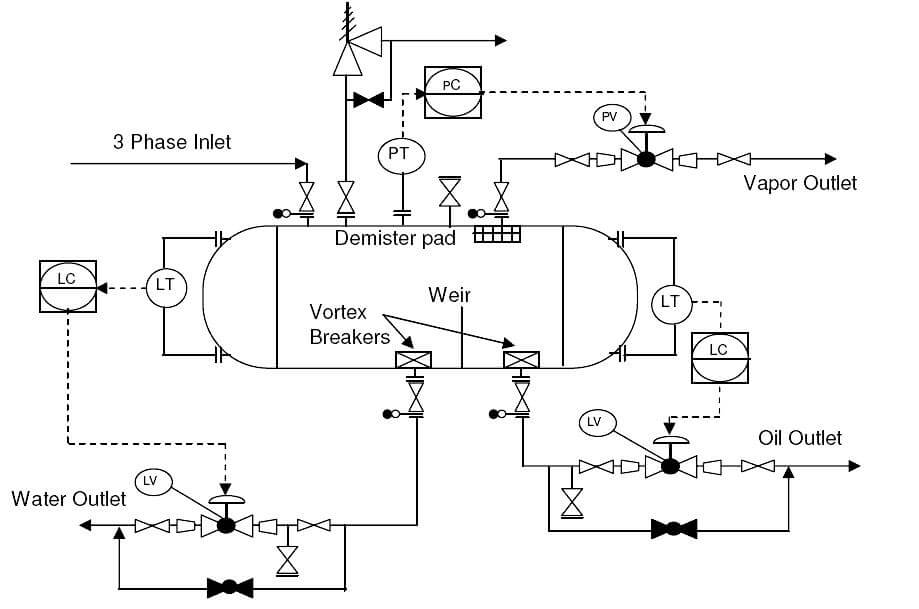3 phase separators are commonly used in upstream oil and gas industry to separate oil, gas and water stream coming from the oil wells. This typical P&ID arrangement can be modified and used for other separator vessels as well.

- Proper vessel symbol should be selected first of all, as shown in the presented drawing. This should be selected from the list of equipment symbols on the legend sheets of a particular project.
- Separator vessel internals should then be indicated as per proper symbols on the legend sheets. These internals can be inlet vane, vortex breaker on the outlet lines, demister pads on gas outlets, weir plate separating the oil and water compartments etc.
- All the nozzles on the separator vessel should then be correctly represented with size and flanges. This includes inlet and outlet nozzles, drains, vents, PSV connection and instrument nozzles, as shown in the sample drawing presented here. Typical instrumentation on the vessel would be level gauges and transmitters on oil and water compartments of the vessel plus pressure gauge and transmitters linked to pressure control or alarms as applicable.
- Inlet and outlet lines are the next to be drawn up. Line number, material class, size etc. is to be correctly assigned to each of the lines.
- Isolation valves, spectacle blinds, spacers etc. to be used for maintenance should be drawn up next on the inlet / outlet lines. The spectacle blinds, spacers etc. are usually connected right next to the isolation valves and equipment nozzles, as indicated in the sample drawing presented here.
- Instrumentation on the vessel should be drawn up next. Typically this would include level gauges, level transmitters, pressure gauges, pressure transmitters as per requirement for control, alarm and trip if applicable. The sample drawing presented here only indicates transmitters, but generally they are accompanied by gauges for local indication and also transmitters for alarms and trips.
- Various control valves should be drawn up next wherever applicable. Sample drawing indicates level control on oil and water outlet lines. Plus pressure control is indicated on the vapor outlet to flare. These control valves should be equipped with either a bypass or handwheel as per project standards, to continue vessel operation in case of control valve maintenance.
- Drains should be provided either on the vessel or on the bottom outlet lines for complete draining of the vessel and associated piping for maintenance purpose. Sample drawing has indicated drains on the outlet lines through which the vessel and piping can be completely drained. Usually the vessel also has nozzles connecting it directly to the draining system.
- Vents can be present either on the vessel itself or on the vapor outlet line, so that the vessel and associated piping can be completely vented for maintenance. Vent connected directly to vessel is indicated in the sample drawing.
- In most cases the vessel is provided with a blanketing gas connection. This blanketing connection can be with or without pressure control. Although not indicated in the sample drawing, it is important to consider the blanketing gas connection to the vessel.
- For purging the vessel with nitrogen, a connection can be provided directly on the vessel. In some cases purging can be done with steam.
- All the guidelines given here are very general and may be modified as per specific requirements of any particular project.